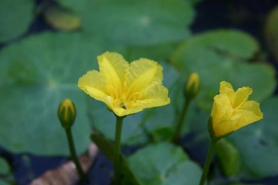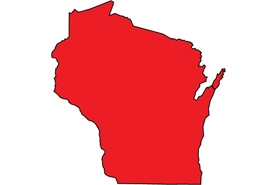Yellow floating heart
(Nymphoides peltata)
Perennial, water-lily-like plant with long-stalked, heart-shaped leaves. It is sometimes used as a water garden plant and can threaten waterbodies if spread to natural areas.
Other names for this plant include:
- Common names: floating heart, fringed water lily, entire marshwort
- Scientific names: N. natans; N. nymphaeoides; Limnanthemum petlatum
Classification in Wisconsin: Prohibited
- Ecological Threat
-
- Invades lakes, riparian zones, watercourses, and wetlands.
- Grows in dense patches, excluding native species and creating stagnant areas with low oxygen levels underneath the floating mats.
- It makes recreational activities like fishing, water skiing, swimming, and canoeing difficult, if not impossible.
- Identification
-
Leaves: Heart-shaped and 3-10 cm across; alternately arranged on the stems and oppositely arranged on the flower stalks. Leaves float on the water surface, have slightly wavy margins and frequently have purplish undersides.
Flowers: 2-5 bright yellow flowers arise from erect flower stalks; 3-4 cm in diameter. Five petals are arranged like the spokes of a wheel, each with a distinctive fringe along the edges.
Fruits & seeds: Fruit is a long-beaked capsule (to 2.5 cm) that splits on one side. One fruit is produced from each flower and contains a few too many smooth, shiny seeds with wing-like margins.
Roots: Short, thick clusters of roots originate from modified stems (rhizomes) growing partly or entirely below the sediment.
Similar species: Spatterdocks (Nuphar spp.), which have much larger leaves and cup-like flowers without fringed petals. Water shield (Brasenia schreberi) has small oval floating leaves often with a jelly-like covering on the undersides, and small purple flowers. Also, other species of Nymphoides (N. aquatica and N. cordatum) are sold as ornamental plants.
- Distribution
-
See the reported locations of yellow floating hearts in Wisconsin.
Do you know of other populations? Please send us a report.
- Control
-
Mechanical: Harvesting can reduce the population, but frequent monitoring and follow-up are required.
Chemical: Aquatic-approved herbicides can be very successful. A licensed applicator must apply the application and may require a permit.
- Resources
- Sources for content:
- Washington State Department of Ecology: Nyphoides peltata [exit DNR]
- Global Invasive Species Database: Nymphoides peltata [exit DNR]. Last updated September 20, 2006.
- Massachusetts Department of Conservation and Recreation Office of Water Resources, Lakes and Ponds Program. "Yellow Floating Heart: An Exotic Aquatic Plant," December 2004


